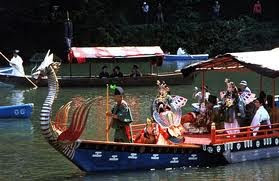:::::::::::::::::::::::::::::::::::::::::::::::::::::::::::::::::::::::::::::::::::::::::::::::::::
Saikusa Lily Festival (Saikusa matsuri)
***** Location: Nara Japan
***** Season: Mid-Summer
***** Category: Observance
*****************************
Explanation
Saikusa matsuri 三枝祭 (さいくさまつり) Saikusa lily Festival
Isagawa matsuri 率川祭(いさかわまつり)Isagawa Shrine festival
... mikusa matsuri みくさ祭(みくさまつり)Mikusa festival
yuri matsuri 百合祭(ゆりまつり) lily festival

Main festival at the shrine Isagawa jinja 率川神社, along the Isagawa river in Nara.
June 17
Isagawa shrine 率川神社(いさがわじんじゃ)
奈良市本子守町

saikusa is an old name for bamboo lilies.
They grow in abundance along the Isagawa river and on the sacred Mount Miwa.
Lilium japonicum, sasayuri ささゆり (笹百合)
nanaotome yuri 七媛女百合, nana otome yuri
nanaotome 七媛女(ななおとめ) Shrine maidens
During the festival black (nigori) and white sake (pure) (shiroki, kuroki) is poured into two barrels as an offering to the shrine deities. These barrels are decorated with many bamboo lilies from Mount Miwa.
This ritual dates back to the reign of Emperor Monmu Tenno 文武天皇 (701–703).
The lilies used for the offering are said to ward off disease. So after all rituals the visitors try to grab one branch to take home and stay healthy until next year.
The lilies are carried to the shrine on the day before the festival.
On the next day after the rituals, the shrine maidens (miko) dace with these branches in their hands.

umasake miwa no mai うま酒みわの舞 Miwa Sake Dance
On this day, many sake brewers from all over Japan come with offerings of their brew, and obtain a ritual cleansing ceremony.
shirokikuroki 白酒黒酒(しろきくろき) ritual sake
son 罇(そん)sake barrel
..... hotogi 缶(ほとぎ

:::::::::::::::::::::::::::::::::::::::::::::::::::::::::::::::::::::::::::::::::::::::::::::::::::::
quote
Saikusa matsuri
This ritual takes place on June 17 at the sessha of Ōmiya Jinja, Isakawa Jinja, in Nara City, Nara Prefecture.
The ceremony begins at around ten in the morning. Four miko (female shrine attendants) perform an offertory dance with torimono (props) made from saigusa no hana, a flower related to a lily that grows wild on Miwayama Mountain.
Because sake casks decorated with mounds of lilies are presented as offerings to the kami, this festival is also known as the yuri matsuri (Lily Festival).
The present ritual is a Meiji period reconstruction, but the origins of the ritual are ancient and there are references to it in both the Jingiryō and the Engishiki.
source : Mogi Sakae, Kokugakuin 2006
:::::::::::::::::::::::::::::::::::::::::::::::::::::::::::::::::::::::::::::::::::::::::::::::::::
quote
Japan is a country of lilies.
Of the total 96 species all over the world, 15 species are indigenous to Japan. The Japanese have been fond of lilies and sometimes regarded them as sacred plants.
YURI, the Japanese word for depicting lily, comes from the old Japanese word YURU that means "swing".
It seems that ancient people named the plant after the sight of its flowers swinging in the wind. The Japanese often use YURI as a girl's name, and sometimes add SA to become SAYURI. This SA means "sacred" in old Japanese.
Lilies were sacred plants in ancient times.
There is a festival called SAIKUSA MATSURI (SAIKUSA = old name of SASAYURI, Lilium japonicum, MATSURI = festival) in Nara Prefecture. Here, four maidens have a dance performance for the gods holding the flowers of Lilium japonicum. This festival has continued since early 8th century.
With many names of the lily variations in Japan:
source : plantsandjapan
:::::::::::::::::::::::::::::::::::::::::::::::::::::::::::::::::::::::::::::::::::::::::::::::::::
Shrine Isagawa jinja 率川神社 Izakawa jinja, Isakawa jinja


food offering for the gods 特殊神饌(しんせん)shinsen :
餅、ワカメ、鯛、カマス、鮎、鰹、烏賊、アワビ、かや、大根、 枇杷、牛蒡、白蒸(ご飯)、勝栗
mochi, wakame, sea bream, kamasu barracuda, sweetfish, bonito, octopus, abalone, torreya nuts, radish, biwa loquats, burdock, cooked rice and auspirious dried chestnuts (kachiguri).
source : lalalasayu.jugem.jp
with more photos of the festival
Maybe the oldest shrine in Nara, built by Emperor Suiko Tenno 推古天皇 in 593.
Oomiwa no kimi shiratsutsumi 大三輪君白堤 is a priest of the Omiwa clan.
Deities in residence
Himetatarai suzuhime no mikoto 媛蹈韛五十鈴姫命 (御子神) Empress
Sainoookami 狭井大神 (御父神)her father
Tamakushi hime no mikoto 玉櫛姫命 (御母神)her mother
This is one of the few shrines where the main deity is female. She was the consort of the first emperor, Jinmu Tenno 神武天皇】.
She is a child-protecting deity 子守明神.
Annual Festivals
January 1 歳旦祭併御神火拝戴祭
January 4 率川阿波神社初戎宵宮祭
January 5 率川阿波神社初戎祭
February 17 率川神社月次祭併祈年祭
September 17 率川神社月次祭併敬老祭
November 23 率川神社新嘗祭

amulets to ward off evil influence and disease
Since the main deity is female, this shrine sells amulets for easy childbirth, bringing up children safely and a good family life.

ema with the lily dance
Homepage of the shrine 率川神社
source : www.isagawa-jinja.jp
. Amulets and Talismans from Japan .
*****************************
Worldwide use
*****************************
Things found on the way
*****************************
HAIKU

献灯の和紙に雨滲む百合祭
kentoo no washi ni ame shimu yuri matsuri
the paper of the lanterns
is dampend by the rain -
lily festival
Fujita Toshio 藤田壽穂
. Discussion of the translation .
:::::::::::::::::::::::::::::::::::::::::::::::::::::::::::::::::::::::::::::::::::::::::::::::::::::::::::::::::
玉虫の羽のみどりは推古より
tamamshi no hane no midori wa Suiko yori
the green
of the Jewel Beetle's wings
since the time of Suiko . . .
Tr. Gabi Greve
. Yamaguchi Seison 山口青邨 .
. tamamushi 玉虫 / 金花虫 (たまむし) jewel beetle
Its wings are used to produce colorful laquer items.
The famous Tamamushi Zushi tabernacle.
:::::::::::::::::::::::::::::::::::::::::::::::::::::::::::::::::::::::::::::::::::::::::::::::::::::::::::::::::
百合祭寂ぶ奈良町の一遇に
河合佳代子
七媛女百合もて供奉をしたがへて
河合佳代子
source : www.haisi.com
*****************************
Related words
***** . Sake, local rice wine .
***** . Lilies and Kigo
***** . Mount Miwa 三輪山, a sacred region .
. OBSERVANCES – SUMMER SAIJIKI .
BACK : Top of this Saijiki
[ . BACK to WORLDKIGO . TOP . ]
:::::::::::::::::::::::::::::::::::::::::::::::::::::::::::::::::::::::::::::::::::::::::::::::::::::










































